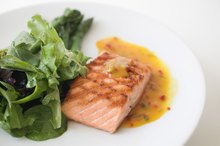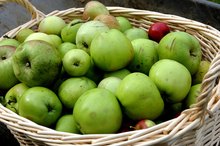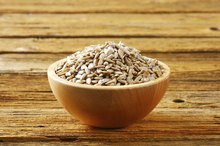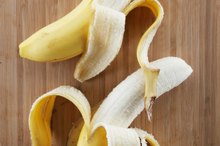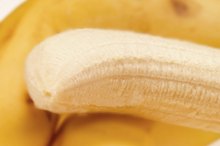High-Protein & Low-Potassium Foods
Under ordinary circumstances, a diet rich in potassium helps you maintain proper nerve and muscle function. But chronic kidney disease and other medical conditions interfere with the body’s natural regulation of potassium in the bloodstream 1. Patients with these conditions require a low-potassium diet, and finding quality sources of protein that fit these potassium guidelines can be challenging.
Potassium Restrictions
Too much potassium in the bloodstream leads to muscle weakness, heartbeat irregularities and, in extreme cases, death. Low-potassium diets generally allow between 1,500 and 2,700 milligrams of potassium per day, with low-potassium foods defined as servings with less than 200 milligrams. Quality protein sources have at least 8 grams of protein per serving.
Meat Protein
Eating Too Much Potassium
Learn More
Meat and fish products are very high in protein, but they tend to have high amounts of potassium. It is important to portion these food items correctly. A 2-ounce serving of cooked chicken contains 200 milligrams of potassium and nearly 18 grams of protein. A 3-ounce serving of canned tuna contains 200 milligrams of potassium and 22 grams of protein, though most other types of seafood should be avoided. Lean ham is another good choice, with approximately 200 milligrams of potassium and 14 grams of protein in a 2- ounce serving.
- Meat and fish products are very high in protein, but they tend to have high amounts of potassium.
- A 3-ounce serving of canned tuna contains 200 milligrams of potassium and 22 grams of protein, though most other types of seafood should be avoided.
Dairy and Eggs
Dairy products tend to be high in potassium and high in protein. But careful portion control makes dairy and egg products viable options for this type of diet. A single large egg contains 100 milligrams of potassium, and offers 7 to 8 grams of protein. A half-cup of milk contains 185 milligrams of potassium, with 4 grams of protein. A 1-ounce slice of cheese contains roughly 100 milligrams of potassium and 5 to 6 grams of protein.
- Dairy products tend to be high in potassium and high in protein.
- A single large egg contains 100 milligrams of potassium, and offers 7 to 8 grams of protein.
Other Options
Potassium Levels in Meat
Learn More
Vegetables and fruits vary in potassium content but tend to have several grams of protein per serving, making them decent sources. Boiling vegetables before consumption releases much of their potassium. Draining the water from veggies reduces your overall potassium intake. Good choices include green beans, which contain 180 milligrams of potassium and 2 grams of protein per cup serving; and cauliflower, which contains 160 milligrams of potassium and 2 grams of protein per half-cup serving. Soybeans and most other types of beans are high in potassium, with more than 800 milligrams per cup serving. Avoid them even when boiled and drained.
- Vegetables and fruits vary in potassium content but tend to have several grams of protein per serving, making them decent sources.
- Soybeans and most other types of beans are high in potassium, with more than 800 milligrams per cup serving.
Related Articles
References
- The National Kidney Foundation: Potassium and Your CKD Diet
- Aburto, et. al. Effect of increased potassium intake on cardiovascular risk factors and disease: systematic review and meta-analyses. BMJ. 2013 Apr 3;346:f1378. DOI: 10.1136/bmj.f1378.
- Appel LJ, Moore TJ, Obarzanek E, et al. A clinical trial of the effects of dietary patterns on blood pressure. DASH Collaborative Research Group. N Engl J Med. 1997;336(16):1117-1124.
- Ferraro PM, et. al. Dietary Protein and Potassium, Diet–Dependent Net Acid Load, and Risk of Incident Kidney Stones. CJASN. October 2016, 11 (10) 1834-1844; DOI: 10.2215/CJN.01520216
- Granchi, D, et. al. Potassium Citrate Supplementation Decreases the Biochemical Markers of Bone Loss in a Group of Osteopenic Women: The Results of a Randomized, Double-Blind, Placebo-Controlled Pilot Study. Nutrients. 2018 Sep 12;10(9). pii: E1293. DOI: 10.3390/nu10091293.
- Linus Pauling Institute. Potassium.
- Macdonald, HM, et. al. Effect of potassium citrate supplementation or increased fruit and vegetable intake on bone metabolism in healthy postmenopausal women: a randomized controlled trial. Am J Clin Nutr. 2008 Aug;88(2):465-74.
- National Institute of Health. Office of Dietary Supplements. Potassium.
Writer Bio
Based in Cleveland, Derek Bryan has been writing professionally since 2009. Focusing on nutrition, health and fitness, Bryan has been featured on several notable health-related websites, including CAMCommons.com. Bryan holds an English degree from the Ohio State University, with a specialty in rhetoric and composition.

